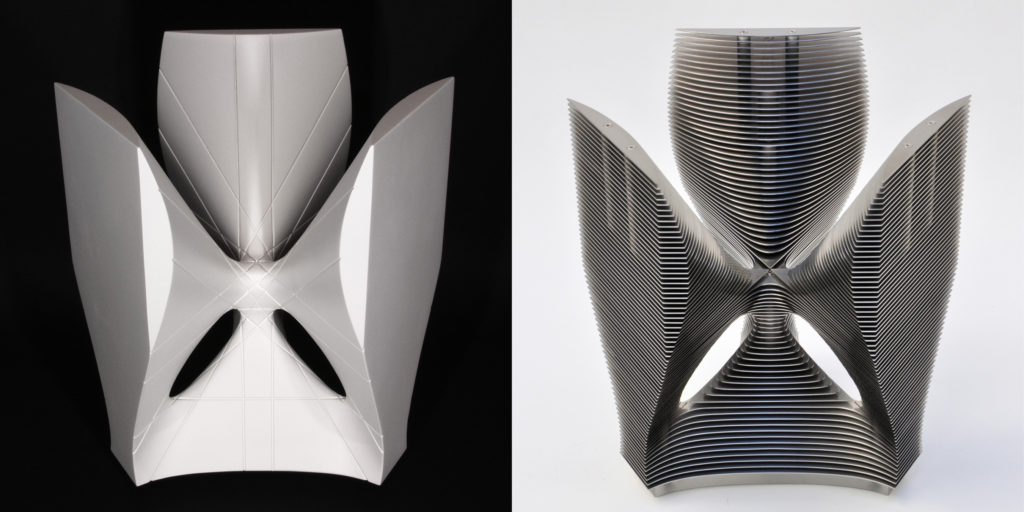
27 Geraden Konfiguration 10
die beiden abbildungen stellen auf unterschiedliche weise die oberfläche dar, auf der sich die 27-geraden-konfiguration abbilden lässt. sie wurde in der 2. hälfte des 19. jahrhunderts vom deutschen mathematiker alfred clebsch (1833-1872) entdeckt und nach ihm benannt. das objekt auf der linken seite wurde 1985 aus 150 schichten aus 2 mm dicken polystyrolplatten hergestellt, die mit einem Lösungsmittel aufeinander geklebt wurden. das objekt auf der rechten seite wurde 2020 aus 75 schichten aus 1 mm dicken edelstahlblechen hergestellt, die mit 3 mm luftzwischenraum zusammengesetzt wurden. beide objekte besitzen dieselben mathematischen grundlagen und sind deshalb in form und größe gleich, abgesehen von kleinen abweichungen, die durch das material und den herstellungsprozess bedingt sind. wurde das modell von 1985 noch ausschließlich in handarbeit gefertigt, so wurde vom zweiten modell 35 jahre später ein datensatz erstellt, nach dem die einzelnen schichten mit hilfe eines lasers geschnitten wurden. die anschließende montage erfolgte jedoch wieder in handarbeit.
the two illustrations show different aspects of the surface on which the 27-line configuration can be projected. the surface is named after the german mathematician alfred clebsch (1833-72), who discovered it in the second half of the 19th century. the object on the left was constructed in 1985 and comprises 150 layers of 2 mm thick polystyrene plates bonded together with a solvent. the object on the right was constructed in 2020 and comprises 75 layers of 1 mm thick stainless steel sheets separated by 3 mm air gaps. these two objects share the same mathematical basis and are therefore identical in form and size, apart from minor deviations caused by different materials and production processes. the 1985 model was constructed entirely by hand. thirty-five years later, the second model was constructed by first compiling a data set and then cutting single layers with the aid of a laser. the object itself was, however, subsequently assembled manually.

die beiden abbildungen stellen auf unterschiedliche weise die oberfläche dar, auf der sich die 27-geraden-konfiguration abbilden lässt. sie wurde in der 2. hälfte des 19. jahrhunderts vom deutschen mathematiker alfred clebsch (1833-1872) entdeckt und nach ihm benannt. das objekt auf der linken seite wurde 1985 aus 150 schichten aus 2 mm dicken polystyrolplatten hergestellt, die mit einem Lösungsmittel aufeinander geklebt wurden. das objekt auf der rechten seite wurde 2020 aus 75 schichten aus 1 mm dicken edelstahlblechen hergestellt, die mit 3 mm luftzwischenraum zusammengesetzt wurden. beide objekte besitzen dieselben mathematischen grundlagen und sind deshalb in form und größe gleich, abgesehen von kleinen abweichungen, die durch das material und den herstellungsprozess bedingt sind. wurde das modell von 1985 noch ausschließlich in handarbeit gefertigt, so wurde vom zweiten modell 35 jahre später ein datensatz erstellt, nach dem die einzelnen schichten mit hilfe eines lasers geschnitten wurden. die anschließende montage erfolgte jedoch wieder in handarbeit.
the two illustrations show different aspects of the surface on which the 27-line configuration can be projected. the surface is named after the german mathematician alfred clebsch (1833-72), who discovered it in the second half of the 19th century. the object on the left was constructed in 1985 and comprises 150 layers of 2 mm thick polystyrene plates bonded together with a solvent. the object on the right was constructed in 2020 and comprises 75 layers of 1 mm thick stainless steel sheets separated by 3 mm air gaps. these two objects share the same mathematical basis and are therefore identical in form and size, apart from minor deviations caused by different materials and production processes. the 1985 model was constructed entirely by hand. thirty-five years later, the second model was constructed by first compiling a data set and then cutting single layers with the aid of a laser. the object itself was, however, subsequently assembled manually.